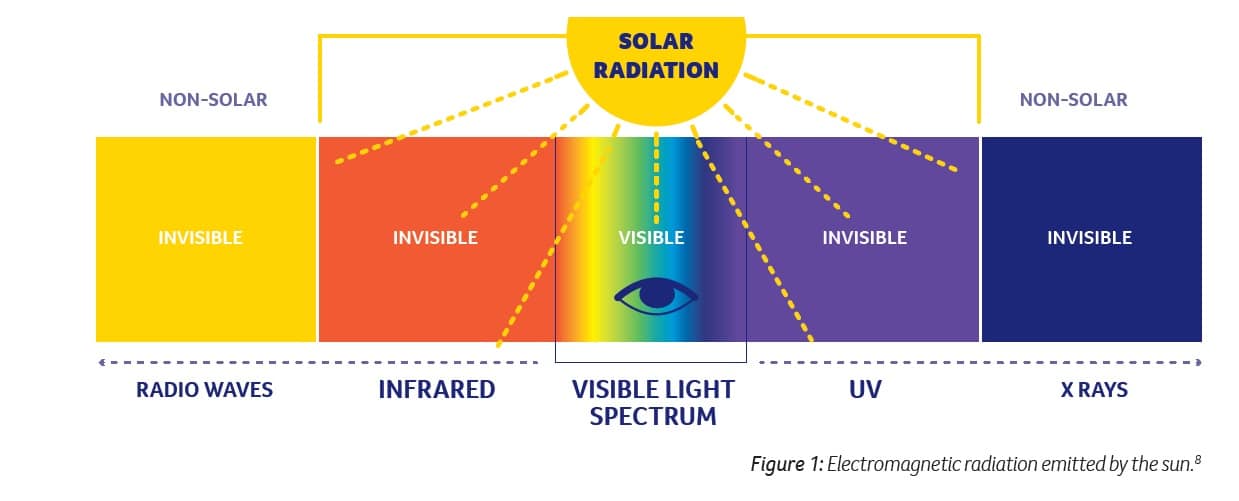
Understanding UV
About UV radiation
Ultraviolet (UV) radiation is a type of energy produced by the sun and some artificial sources, such as solariums. UV radiation is not part of the visible spectrum of light, nor is it thermal radiation or heat – unlike sunlight it cannot be seen, nor can it be felt like the sun’s warmth.
Overexposure to ultraviolet (UV) radiation from the sun is the major cause of skin cancers. Little can or should be done to change the levels of solar UV radiation, instead we need to reduce our UV exposure and therefore, hopefully, subsequent skin cancers.
Australia has some of the highest levels of UV radiation in the world – in fact, UV radiation is strong enough to cause sunburn in as little as 10 minutes on a fine January day.
UV radiation is divided into three types, categorised by wavelength: UVA, UVB and UVC.
While all UVC radiation is absorbed by the atmosphere, all UVA and about 10 per cent of UVB radiation does reach the Earth’s surface.
- UVA can cause sunburn, DNA (cell) damage in the skin and skin cancer.
- UVB causes skin damage and skin cancer.
- UVC is the most dangerous type of UV. Ozone in the atmosphere absorbs all UVC and it does not reach the earth’s surface.
Factors affecting levels of UV radiation
UV radiation can reach you on the ground directly from the sun. It can also be scattered by particles in the air and reflected by ground surfaces such as metal, concrete, sand and snow.
Levels of UV radiation are also affected by:
- Sun elevation — the higher the sun is in the sky, the higher the levels of UV radiation at the Earth’s surface. Therefore, levels of UV radiation are highest in the middle of the day, and during summer months.
- Latitude — the closer to the equator you are, the higher the levels of UV radiation.
- Cloud cover — UV radiation can pass through light cloud cover, and on lightly overcast days the intensity of UV radiation can be similar to that of a cloud free day. Heavy cloud can reduce the intensity of UV radiation. Scattered cloud has a variable effect on levels of UV radiation, which rise and fall as clouds pass in front of the sun.
- Altitude — at higher altitudes, the atmosphere is thinner and absorbs less UV radiation.
- Ozone — ozone absorbs some of the UV radiation that would otherwise reach the Earth’s surface.

The UV Index, a rating system adopted from the World Health Organization, describes the amount of UV radiation at the Earth’s surface.
The UV Index
The UV Index is a standard and useful measure scale which tells us how strong the UV is and how to protect ourselves accordingly. Whenever the UV is 3 or above, sun protection is required. The higher the level, the shorter time it takes for skin damage to occur.
Sun protection times
Sun protection times are a daily time period showing when UV levels are predicted to be 3 or above, and sun protection is needed. The sun protection times vary according to your location and will change throughout the year.

Understanding UV – How to read the UV forecast

Download the free SunSmart Global UV app
Our free SunSmart Global UV app puts sun protection advice at your fingertips, provides reliable at-a-glance real-time and forecast UV levels for locations across Australia and the world from reputable and trusted agencies and translates this data into clear, evidence-based health advice from Cancer Council Victoria to recommend sun protection for your location.
Five facts about UV
In Australia, we’re exposed to some of the harshest and most dangerous levels of ultraviolet (UV) radiation in the world.
UV Index widget
Take away the guesswork of daily UV by adding the free SunSmart widget to your website

Download SunSmart resources
Cancer Council WA have a range of free resources to download and order.